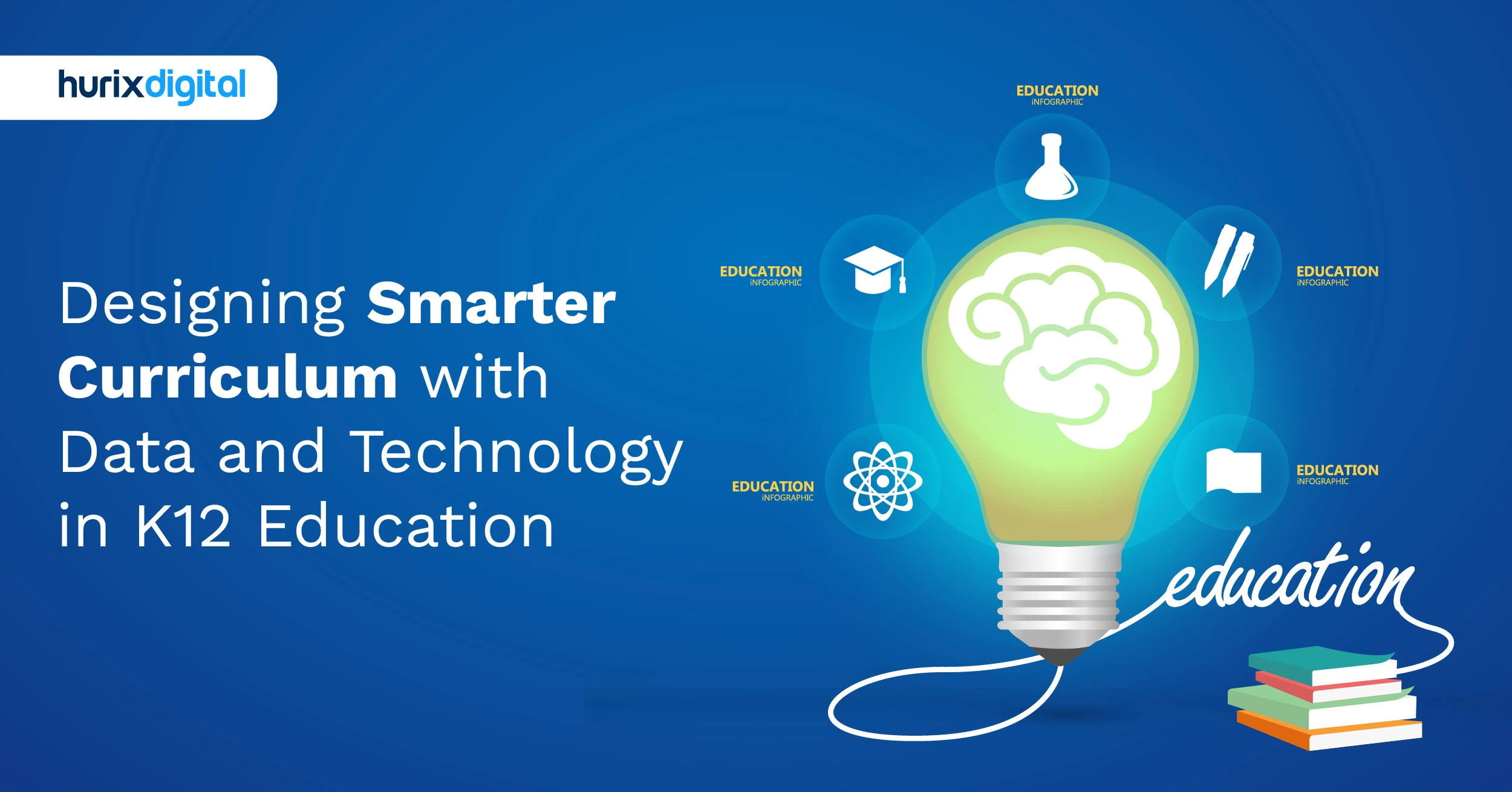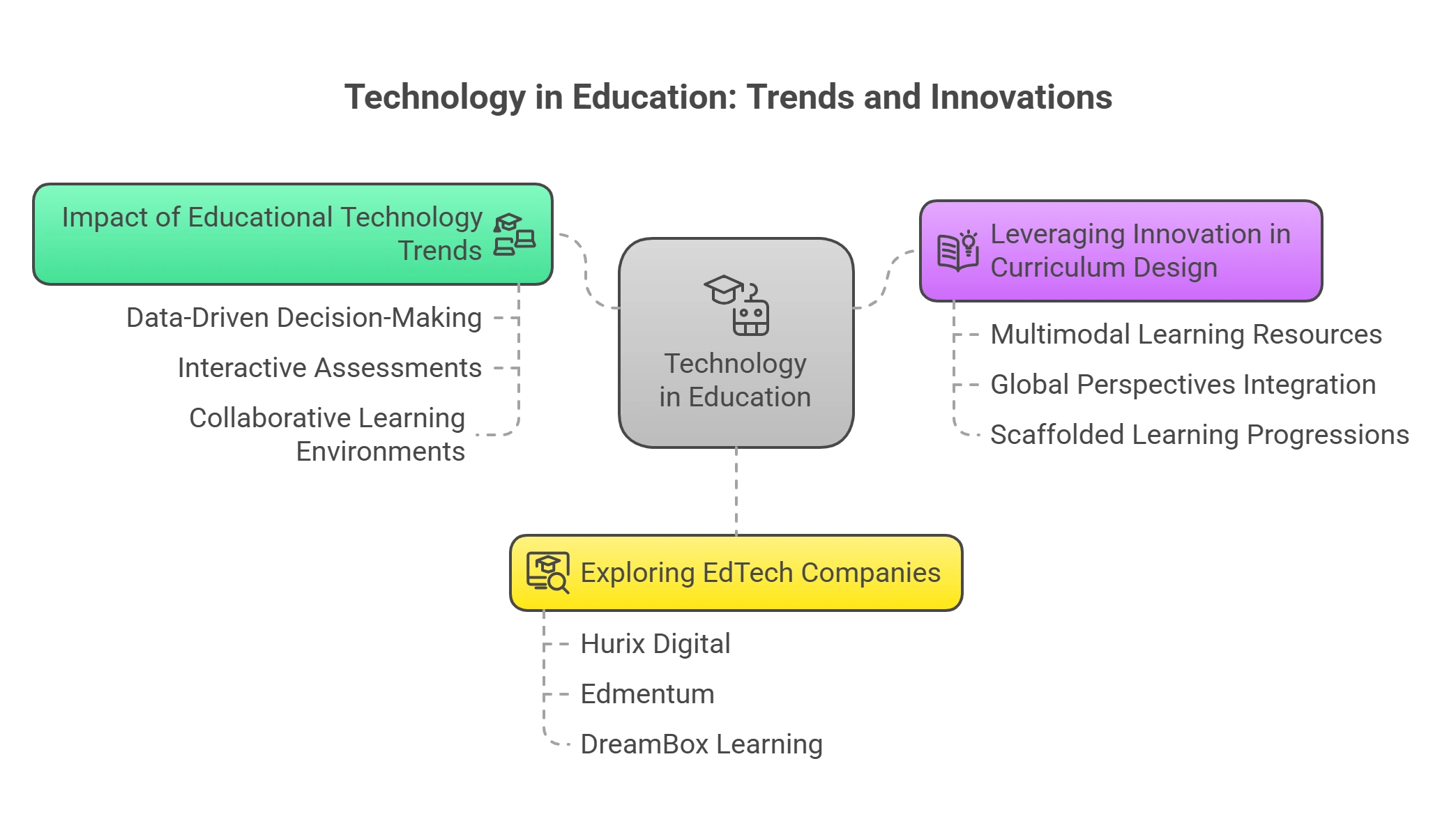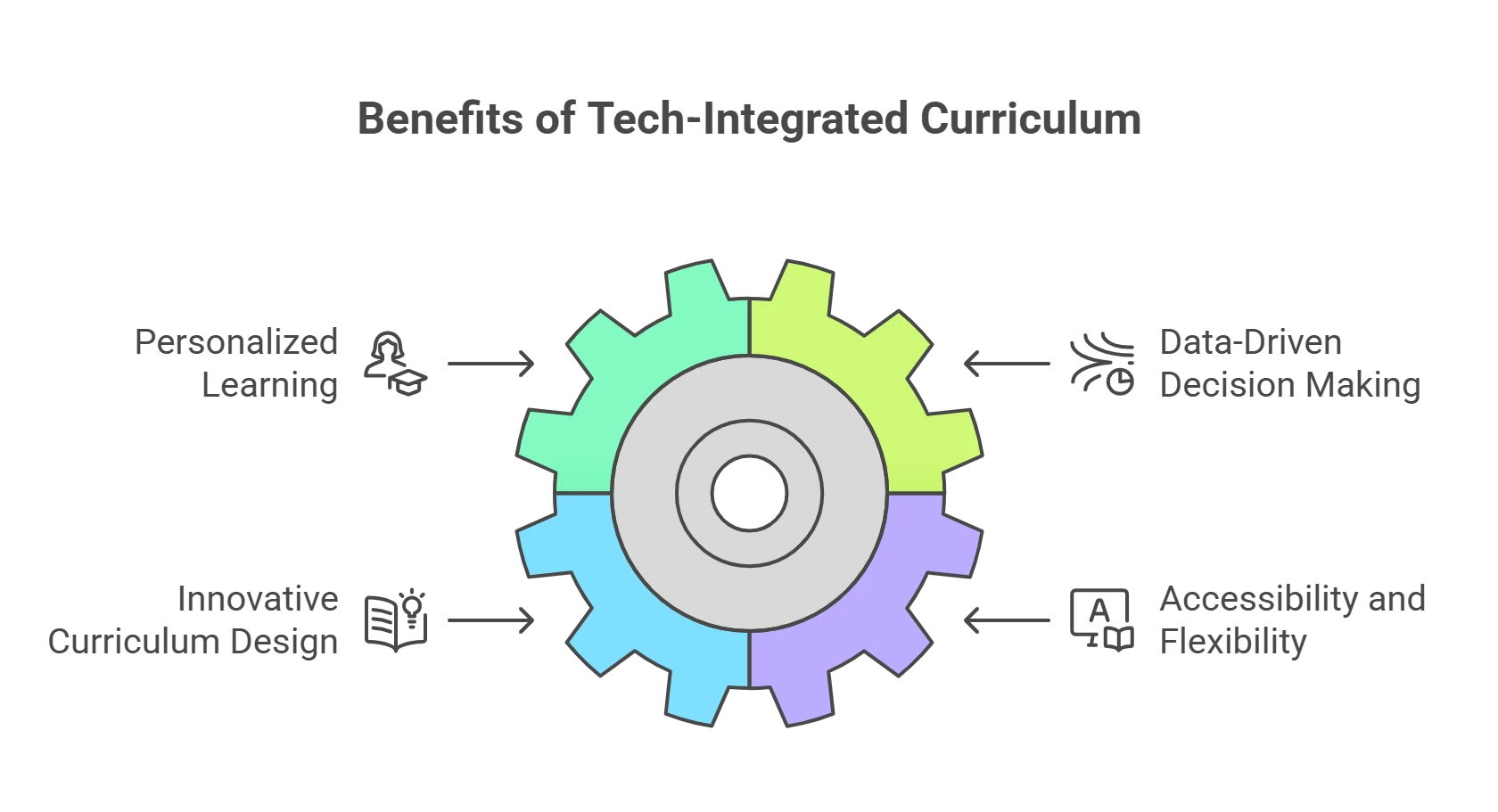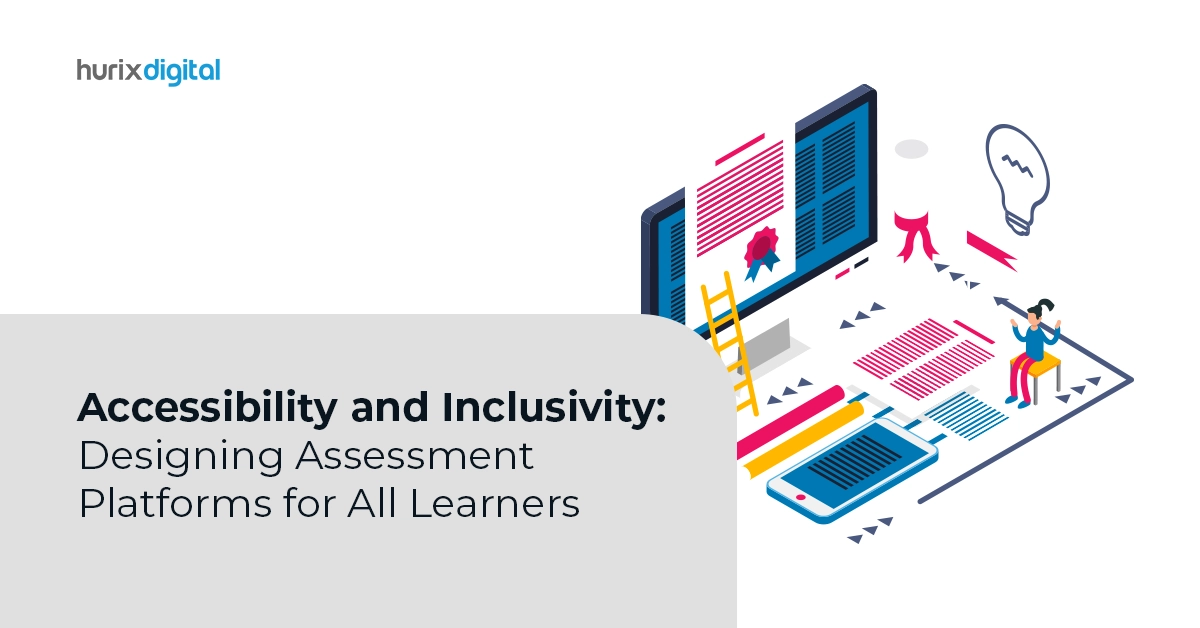
Designing Smarter Curriculum with Data and Technology in Education
Summarize with:
With technological advancement, we are in the midst of a significant change. This change affects various fields and industries, and education is no different. In this changing environment, how can we shape the future of education through innovative curriculum design and technology integration?
Curriculum innovation is at the front of this transformation, driving educational excellence and preparing students for the digital age. It has become essential for the education industry to integrate this curriculum for learners. But how?
In this blog, we will answer this and explore technology in the educational industry and the possibilities of a tech-integrated curriculum innovation for learners.
Table of Contents:
- The Role of Technology in Education
- The Advantages of a Tech-Integrated Curriculum
- Implementing Tech-Integrated Curriculum in Education
- The Role of Higher Education Analytics
- Strategies for Higher-Ed Program Optimization
- Evolving Priorities in Higher Education in 2025 and Beyond
- Conclusion
The Role of Technology in Education
Technology has revolutionized the way we teach and learn, offering many possibilities for engagement and personalized learning experiences.
Embracing educational technology trends is crucial for staying relevant in today’s educational environment. By incorporating digital learning tools effectively, educators can enhance student outcomes and encourage a culture of continuous improvement in this environment.

1. Understanding the Impact of Educational Technology Trends
Technology greatly impacts the world, and the education sector is no different. So, let’s have a look at the impacts of educational technology trends:
- Data-Driven Decision-Making: Technology enables educators to gather real-time data on student performance, allowing for targeted interventions and personalized learning plans tailored to each student’s strengths and weaknesses.
- Interactive Assessments: Educational technology trends emphasize interactive assessments beyond traditional tests, incorporating multimedia elements, simulations, and real-world scenarios to gauge student understanding and skills effectively.
- Collaborative Learning Environments: Technology facilitates collaborative learning experiences where students can engage in group projects, peer reviews, and virtual discussions, encouraging teamwork and communication skills essential for the modern workforce.
2. Leveraging Innovation in Curriculum Design
Though the tech-integrated curriculum is designed to cater to the students, it can be enhanced through innovation. Here are some of the innovations to elevate the curriculum design:
- Multimodal Learning Resources: Innovative curriculum design integrates various learning modalities, including videos, podcasts, interactive simulations, and hands-on activities, to cater to diverse learning preferences and enhance student engagement.
- Global Perspectives Integration: Curriculum innovation embraces global perspectives by incorporating multicultural content, international collaborations, and virtual exchange programs, preparing students for a connected and diverse world.
- Scaffolded Learning Progressions: Effective curriculum design includes scaffolded learning progressions that build upon students’ prior knowledge and skills, ensuring a gradual and structured approach to mastering complex concepts and competencies.
3. Exploring EdTech Companies
eLearning companies in the USA are at the forefront of innovation, offering cutting-edge solutions to enhance teaching and learning experiences. Some notable companies include:
- Hurix Digital: Provides innovative digital learning solutions, including custom eLearning content development and learning management systems, to enhance the learning experience for students.
- Edmentum: Offers personalized learning solutions customized to students, providing adaptive curriculum and assessment tools.
- DreamBox Learning: Specializes in adaptive math programs for elementary students, offering interactive content to support mathematical skill development.
The Advantages of a Tech-Integrated Curriculum
There are numerous benefits of a tech-integrated curriculum in education. Some of these advantages include:

1. Personalized Learning
Personalized learning customizes education to individual needs, enhancing engagement, motivation, and academic performance. It nurtures intrinsic motivation and self-advocacy skills, empowering students to progress at their own pace.
2. Data-Driven Decision Making
Data-driven decision-making uses real-time student data to optimize interventions and learning plans, aiding struggling students in improving their academic outcomes.
3. Innovative Curriculum Design
Innovative curriculum design integrates diverse resources like videos, podcasts, and hands-on activities to engage students with varied learning preferences. It embraces global perspectives and multicultural content for a connected world.
4. Accessibility and Flexibility
Technology offers accessibility and flexibility, enabling learning anytime, anywhere. It breaks geographical barriers, enhances inclusivity, and allows students to learn at their own pace and preferred style, promoting equitable education.
Implementing Tech-Integrated Curriculum in Education
Integrating technology into the curriculum requires strategic planning and a clear vision for success. Educators can create a dynamic learning environment that prepares students for the digital future by following effective strategies and addressing challenges proactively.
1. Strategies for Successful Integration
Dive into some of the strategies for successfully implementing a tech-integrated curriculum:
Empower educators with advanced tech skills through consistent training and workshops, enabling them to incorporate technology into their teaching methodologies seamlessly. Continuous professional development ensures teachers stay abreast of the latest trends and tools, enhancing their ability to engage students effectively in a tech-integrated learning environment.
Ensure that technology implementation is closely aligned with educational objectives to amplify student engagement and academic success. Educators can create a synergistic relationship between technology and learning goals by integrating tech tools purposefully into lesson plans, encouraging a more meaningful and impactful educational experience for students.
Inspire student innovation by integrating tech projects that stimulate creativity and critical thinking skills. By encouraging exploration and experimentation with technology, learners are empowered to think creatively, problem-solve effectively, and express their ideas innovatively, nurturing a culture of creativity in the classroom.
Offer educators continuous tech support to navigate challenges and fully leverage the potential of technology in teaching. Providing ongoing assistance ensures that teachers feel confident in utilizing tech tools, troubleshooting effectively, and integrating technology seamlessly into their instructional practices, ultimately enhancing the overall learning experience for students.
Integrate technology seamlessly into the existing curriculum to create a cohesive learning environment that maximizes the benefits of tech tools. By organizing technology into lesson plans and activities, educators can enhance educational outcomes, promote student engagement, and facilitate a smooth transition to a tech-integrated educational approach.

2. Overcoming Challenges in Adoption
Here are some of the steps to follow to overcome the challenges while adopting the curriculum:
- Infrastructure Accessibility: Address limitations in infrastructure to ensure equitable access to technology for all students, bridging the digital divide in education.
- Data Security: Prioritize data privacy and security in digital learning environments, implementing robust measures to safeguard student information and maintain confidentiality.
- Continuous Training: Offer ongoing support and training for educators to build confidence in utilizing technology effectively, promoting a culture of continuous learning and growth.
- Effective Communication: Implement clear communication strategies to facilitate smooth tech adoption, ensuring all stakeholders are informed and engaged in the process.
- Engaging Stakeholders: Involve parents and stakeholders in the adoption process, enabling collaboration and understanding to create a supportive environment for tech integration in education.
The Role of Higher Education Analytics
Here’s a snapshot of the role of higher education analytics in optimizing learning for students:

1. Diverse Data Sources
Higher education analytics include a wide range of data sources, such as enrollment information, student performance metrics, and feedback forms. These resources offer a thorough analysis of the state of education today.
Additional sources such as demographics, financial records, course evaluations, and engagement metrics from digital platforms contribute crucial insights. Analyzing these diverse datasets together offers a nuanced understanding of institutional performance and student behavior, revealing patterns that may not be apparent when data is examined individually.
2. Transform Your Learning Programs Via Analytics
Analytics plays a pivotal role in optimizing learning programs by pinpointing areas needing improvement, personalizing learning experiences, and assessing the effectiveness of educational interventions.
Predictive analytics can identify children dropping out and allow early intervention. Learning analytics may also evaluate the effects of various teaching pedagogies and enable teachers to adjust their approaches based on what is most effective.
Another important benefit is personalization, which can utilize the data to customize educational materials to meet student demands and learning styles for improved results.
Strategies for Higher-Ed Program Optimization
Here are some strategies that can optimize higher education programs:

1. Identify Key Performance Indicators (KPIs)
Defining KPIs is essential to optimizing higher education programs. Graduation rates, student satisfaction ratings, and employment rates following graduation are examples of common KPIs. It incorporates statistics like student engagement, instructor performance reviews, and course completion rates.
Institutions can monitor their progress and make data-driven decisions leading to improvement in program quality and student outcomes by establishing explicit and definable KPIs.
2. Utilize Predictive Analytics
Program directors can proactively address all the possible problems and improve program delivery by using these analytics to forecast future trends and students’ behavior.
To do this, models that predict outcomes like student success rates, possible dropout risks, and the best use of available resources are developed using previous data. Institutions can enhance program performance by implementing tailored learning programs, targeted interventions, and strategic planning.
3. Implement Continuous Improvement Processes
Programs are continuously evaluated, and changes are part of a continuous improvement process using data insights. This strategy guarantees that programs stay efficient and relevant.
It involves gathering input from interested parties, evaluating programs regularly, and improving curriculum, instruction, and support services. By promoting a culture of continual development, educational institutions may adjust to changing demands, improve student experiences, and uphold high academic performance standards.
4. Focus on Data Collection Methods
Strong data gathering techniques are the first step toward effective educational data analysis. Common sources include surveys, student records, digital learning environments, and feedback forms. Ensuring complete and accurate data gathering is important for trustworthy analysis.
5. Ensure Data Accuracy and Integrity
Maintain the integrity and accuracy of data. This can be done by using trustworthy data management systems and performing routine data audits. Maintaining trust and regulatory compliance also depends on ensuring data security and privacy.
Evolving Priorities in Higher Education in 2025 and Beyond
Here’s a snapshot of the evolving priorities in higher education for 2025 and beyond:

1. Enhancing Data Security and Governance
In 2025, higher education institutions are prioritizing improvements in data security, hybrid work environments, data-informed decision-making, mental health support, equity, digital transformation, and hybrid learning.
Businesses are increasing mental health services, embracing new technology for digital transformation, establishing multi-factor authentication and zero-trust settings, and improving data governance procedures. Adopting hybrid work models aims to draw in a varied pool of talent.
2. Driving Digital Transformation
Significant investments in technology and infrastructure, which are improving the capacities of hybrid and online learning, are highlighting a shift towards sustainability, adaptation, and resilience in the face of persistent challenges.
Despite enrollment growth, challenges persist. For example, in one of the largest higher education systems in the world, the number of enrolled women increased by 32% between 2014 and 2015; among 18 to 23-year-olds, mostly attending government colleges, the Gross Enrollment Ratio (GER) is 28.4%.
Government projects such as NEP 2020 and IoE prioritize digital learning, research, and quality. Effective solutions to these problems are sought through partnerships between the public and private sectors and better infrastructure.
3. Promoting Innovation in Teaching and Learning
Higher education establishments are prioritizing encouraging innovation in teaching and learning approaches in 2025.
Managers responsible for developing educational programs might use data in this way to maximize each student’s educational experience. This entails using analytics to pinpoint problem areas, tailor instructional materials, and assess how well teaching methods are working.
Conclusion
Integrating technology into education presents an exciting frontier for enhanced learning experiences. By embracing innovative strategies and overcoming challenges collaboratively, educators can cultivate a dynamic environment that prepares students for the digital age, cultivating creativity, personalized learning, and inclusive education for all.
Hurix Digital helps you envision tomorrow with a tech-integrated curriculum by leveraging innovative educational technology solutions to shape the future workforce and prepare students for the evolving job market. Our innovative educational technology solutions enhance teaching methods and foster interactive learning experiences, equipping students with essential 21st-century skills for the digital age.
Contact us to learn more!
Summarize with:

Senior Vice President
A Business Development professional with >20 years of experience with strong capability to sell new solutions and develop new markets from scratch. New Market Entry Specialist with experience working in the largest emerging markets. Exceptional experience in conceptualizing, ideating and selling new learning technologies like VR AR, etc. across multiple industry verticals.
 Upcoming Masterclass | Build an Army of Brand Evangelists using Training & Development | November 20th, 8:30 AM PDT | 11:30 AM EDT | 10:00 PM IST
Upcoming Masterclass | Build an Army of Brand Evangelists using Training & Development | November 20th, 8:30 AM PDT | 11:30 AM EDT | 10:00 PM IST




